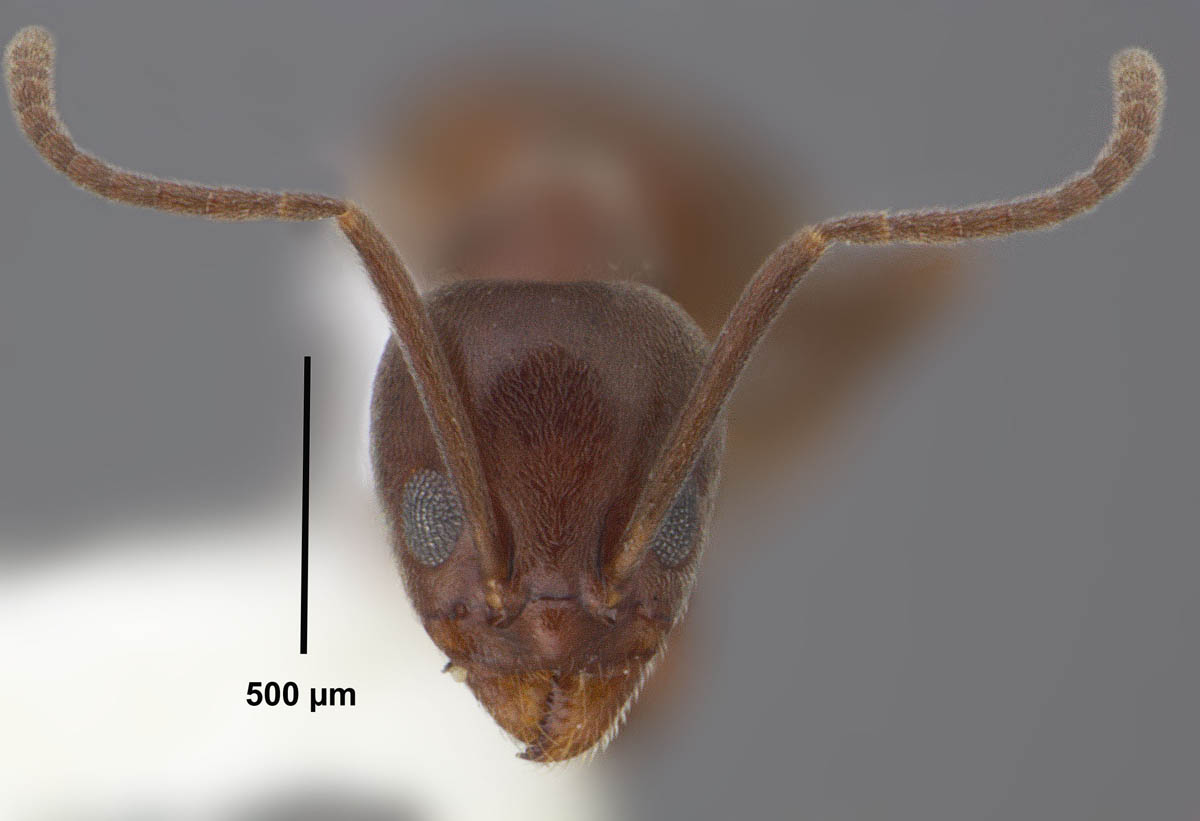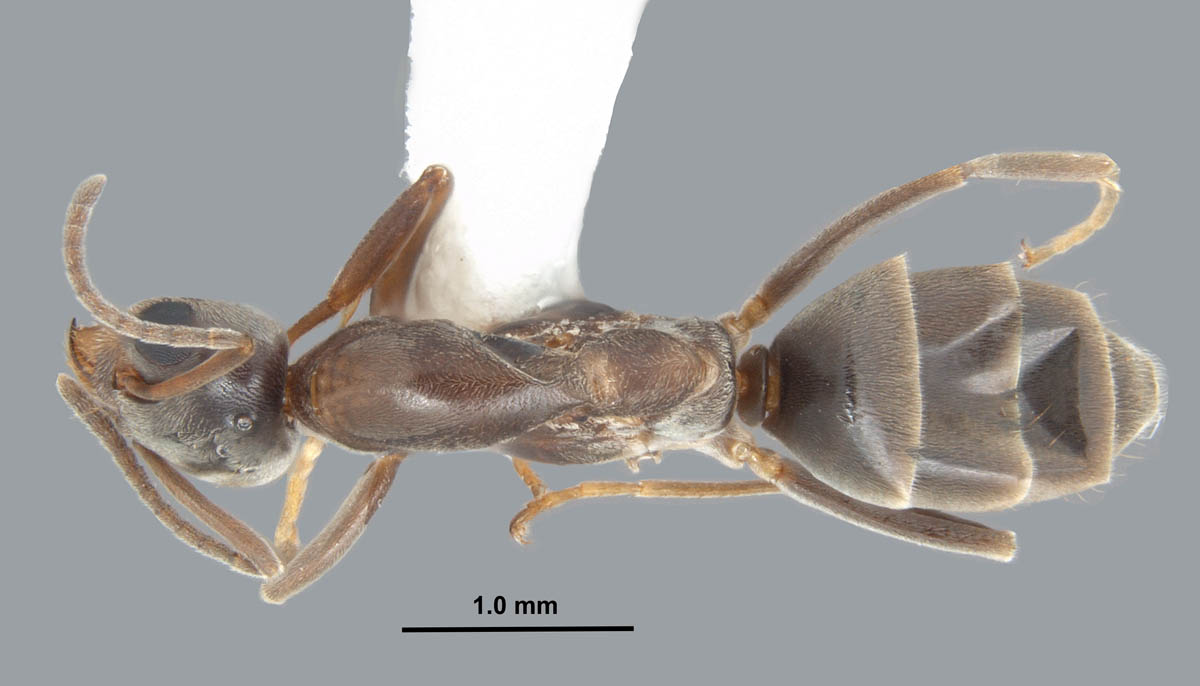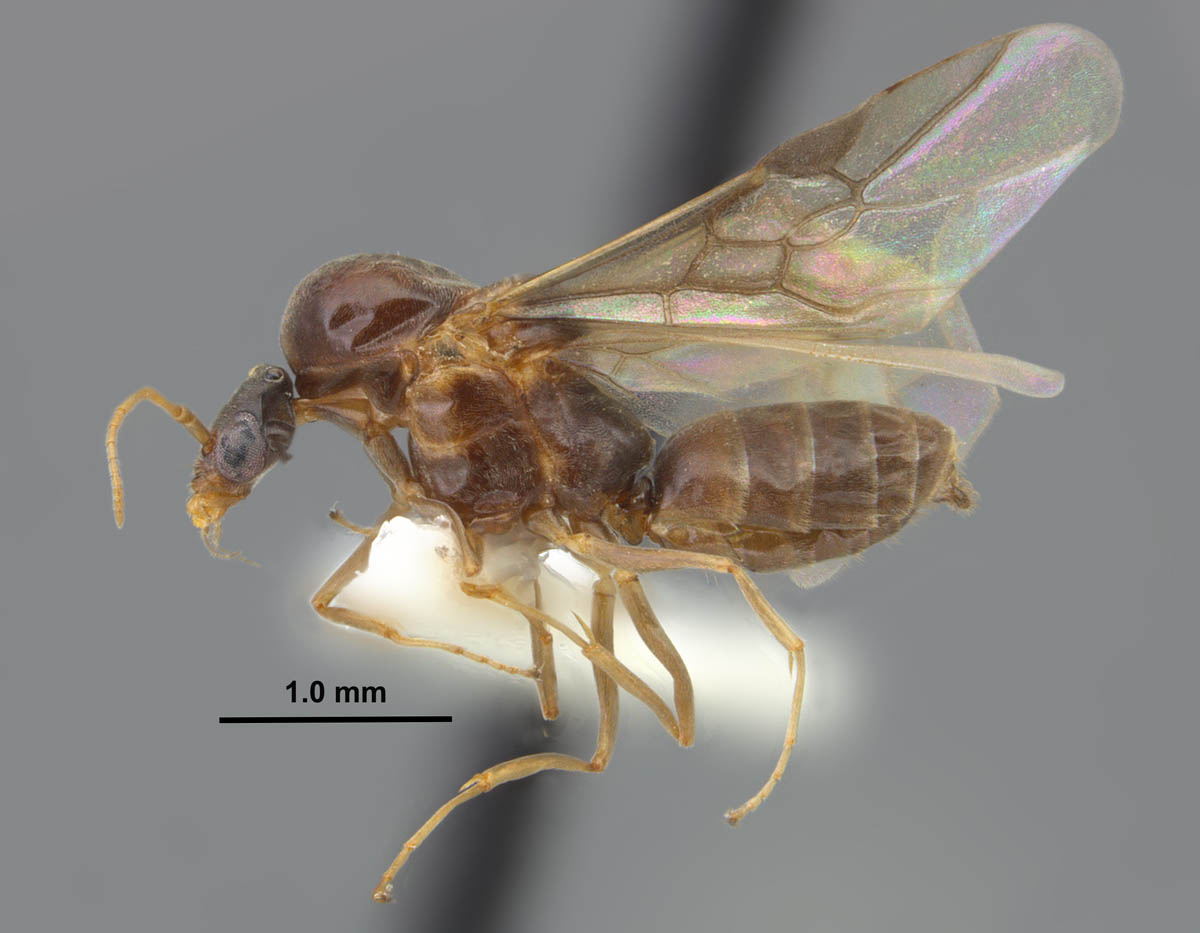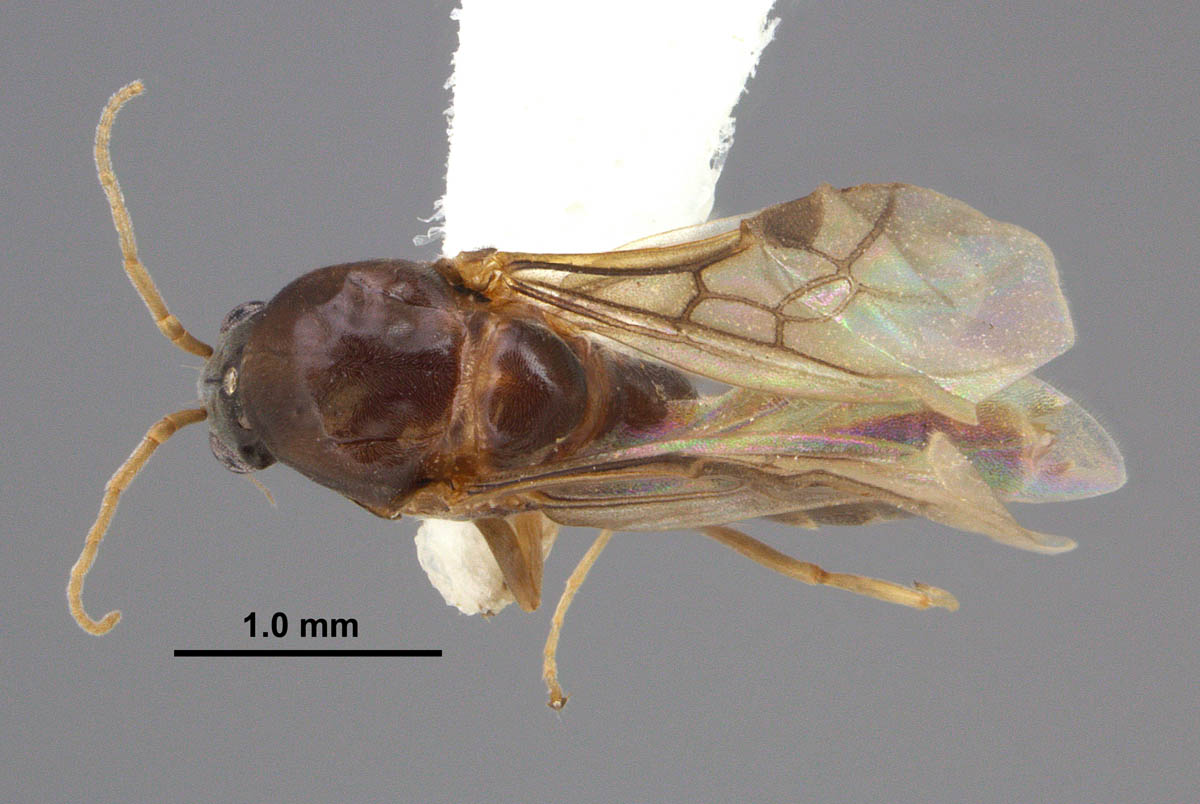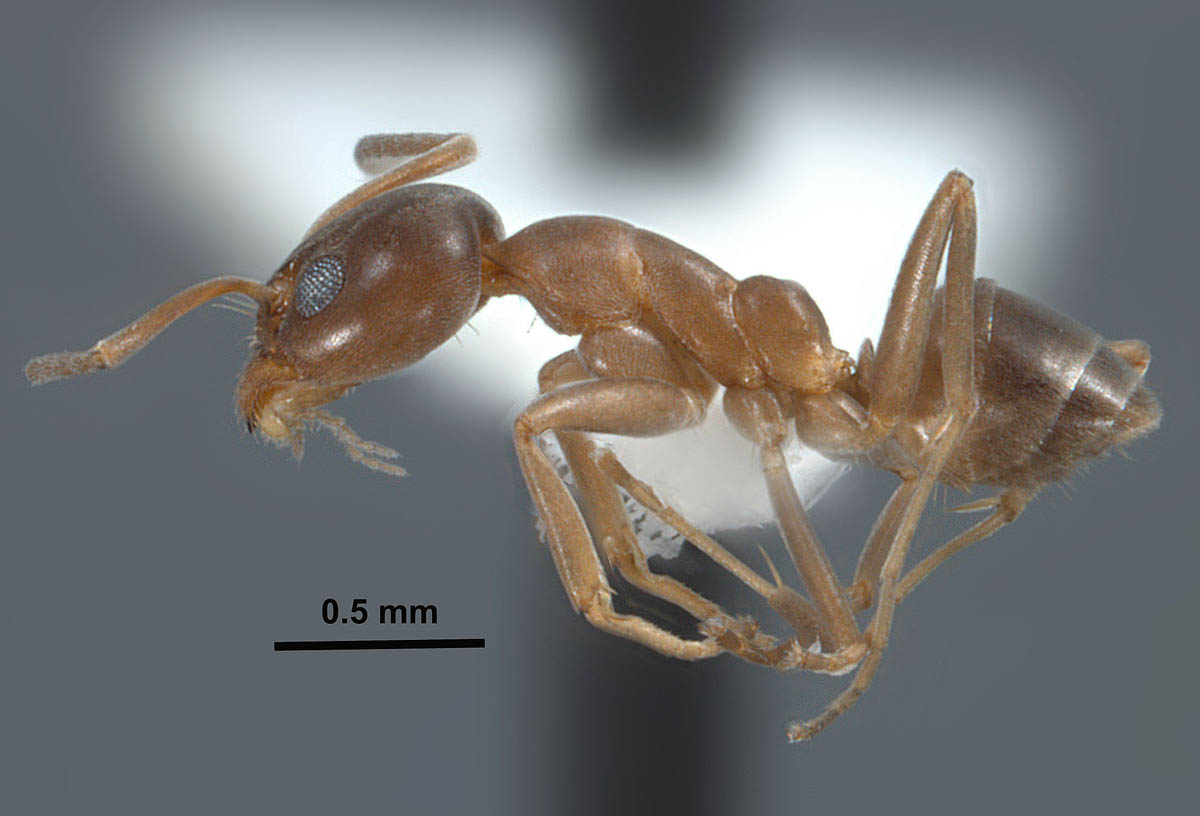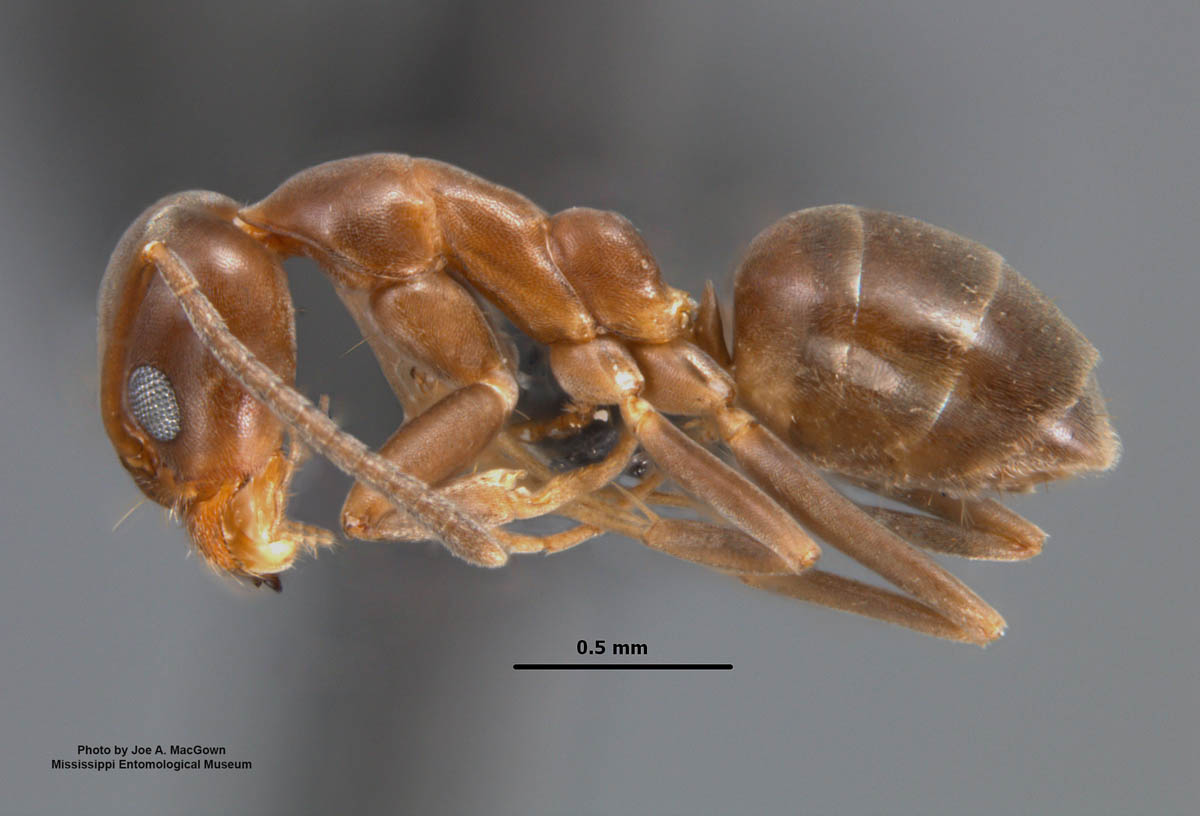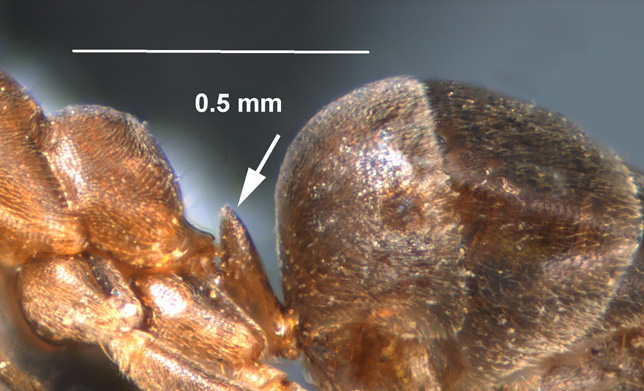Subfamily DOLICHODERINAE Authors: Joe A. MacGown and Ryan J. Whitehouse |
||
Linepithema humile, full face view of a worker (MS, Jackson Co.) (photo by Joe A. MacGown) |
Linepithema humile, lateral view of a worker (MS, Jackson Co.) (photo by Joe A. MacGown) |
Linepithema humile, dorsal view of a worker (MS, Jackson Co.) (photo by Joe A. MacGown) |
Linepithema humile, full face view of a queen (MS, Jackson Co.) (photo by Joe A. MacGown) |
Linepithema humile, lateral view of a queen (MS, Jackson Co.) (photo by Joe A. MacGown) |
Linepithema humile, lateral view of a male (MS, Jackson Co.) (photo by Joe A. MacGown) |
Linepithema humile, full face view of a male (MS, Lauderdale Co.) (photo by Joe A. MacGown) |
Linepithema humile, lateral view of a male (MS, Lauderdale Co.) (photo by Joe A. MacGown) |
Linepithema humile, dorsal view of a male (MS, Lauderdale Co.) (photo by Joe A. MacGown) |
Linepithema humile., lateral view of worker (photo by Joe A. MacGown) |
Linepithema humile, lateral view of worker (photo by Joe A. MacGown) |
Linepithema humile., profile view of worker with arrow pointing to petiolar node. |
Introduction Linepithema humile (Mayr) (Dolichoderinae) the Argentine ant, is a small, brown species native to Argentina and Brazil. The Argentine ant is thought to have first arrived in the United States in coffee shipments to New Orleans sometime near 1891. Since it arrival in the U.S. it has spread eastward into the Carolinas and as far south as Southern Florida and westward into Texas and California. Taxonomic History (Bolton 2016) Identification Queen: Larger than workers (HL 0.91–0.99 mm, HW 0.88–0.96mm, SL 0.91–0.94 mm, EL 0.40–0.42 mm, MeSL 2.16–2.42 mm) (n=5) (MEM specimens). Uniform dark reddish-brown to dark brown to slightly bicolored with head and mesosoma reddish brown and gaster brownish black. Head about as wide as long, squarish; with dense, appressed pubescence that does not completely obscure the shiny integument; longer, erect setae lacking; eyes large, about 1/3 or more the length of the head, located on bottom half of head; three ocelli present; mandibles triangular and multidentate; clypeus with 2–6 setae that are shorter than the closed mandibles; antennae 12-segmented, lacking a club. Mesosoma elongate, dorsum broadly convex with mesocutellum rounded; propodeum unarmed; entire mesosoma lacking sculpture, shiny beneah dense, short, appressed setae; long erect setae lacking. Wings transluscent yellowish brown fading to clear at bottow and apical edges; forewing with brown pterostigma and with closed costal, basal, subbasal, anal, discal, and two submarginal cells; hindwing closed basal and subbasal cells. Waist with single petiolar node, node wider basally and tapering to a point apically (lateral view). Gaster does not overhang the petiole; integument shiny beneath dense, short, appressed setae; longer erect setae lacking except for a few on apical sternites; sting or acidopore lacking. Male: Small, slightly larger than workers (HL 0.64–0.67 mm, HW 0.66–0.69 mm, SL 0.18–0.19 mm, EL 0.34–0.38 mm, MeSL 1.59–1.76 mm) (n=5) (MEM specimens). Brown to brownish black to bicolored with head and gaster darker than the rest of the body, sometimes almost black. Head rounded posteriorly in frontal view, narrowed in lateral view; dense, appressed, short pubescence present; eyes large, about half the length of the head, located on the lower half of the head; three large ocelli present, slightly raised; mandibles small, poorly developed; when closed, the mandibles form a smooth arc; antennae 13-segmented; scape short, subequal in length with third antenomere; last 8 antenomeres shorter. Mesosoma: mesoscutum enlarged, rounded, overhanging and bulging over pronotum; scutellar sulcus deep; mesoscutellum raised above propodeum; propodeum rectangular, declivity rounded, concave, upper part overhanging petiole, lacking spines or adornment; entire mesosoma shiny, lacking sculpture, with dense, appressed, short pubescence; longer erect setae absent. Wings transluscent yellowish brown fading to clear at bottow and apical edges; forewing with brown pterostigma and with closed costal, basal, subbasal, anal, discal, and two submarginal cells; hindwing with closed basal and subbasal cells. Waist with a single small, smooth, rounded, petiolar node. Gaster sometimes overhanging petiole, shiny, lacking sculpture, with dense, appressed, short pubescence; longer erect setae absent except for a few on sternites; genitalia with small parameres. Diagnosis Biology and Economic Importance Due to its ability to nest in a wide range of habitats and to utilized numerous food sources, L. humile can be a a serious household pest. Once infesting a house, these ants are extremely difficult to control or eradicate (Smith 1965). Workers of this species do not have a sting, but have been known to bite when provoked, which helps to increase their pest status (Smith 1965). Ecologically, Argentine ants may outcompete other ant species and other invertabrates in their area. They are known to be especially competitive with Solenopsis species, competing for space and food (Smith 1965). Distribution Australian: Australia, Hawaii, New Zealand, Norfolk Island, Vanuatu (AntWiki.org). U.S. Distribution: AL, AR, AZ, CA, FL, GA, HI, LA, MS, NC, NM, OH, SC, TN, TX, UT (AntWeb.org and MEM). Acknowledgments Literature Cited Bolton, B. 2016. An online catalog of the ants of the world. Online at: http://antcat.org. Accessed 1 October 2016. Crozier, R. H. 1969 ("1968"). Cytotaxonomic studies on some Australian dolichoderine ants (Hymenoptera: Formicidae). Caryologia 21:241-259. Emery, C. 1888. Über den sogenannten Kaumagen einiger Ameisen. Zeitschrift für Wissenschaftliche Zoologie 46:378-412. Forel, A. 1908. Ameisen aus Sao Paulo (Brasilien), Paraguay etc. gesammelt von Prof. Herm. v. Ihering, Dr. Lutz, Dr. Fiebrig, etc. Verhandlungen der Kaiserlich-Königlichen Zoologisch-Botanischen Gesellschaft in Wien 58:340-418. Gallardo, A. 1916. Las hormigas de la República Argentina. Subfamilia Dolicoderinas. Anales del Museo Nacional de Historia Natural de Buenos Aires 28:1-130. Mayr, G. 1868. Formicidae novae Americanae collectae a Prof. P. de Strobel. Annuario della Società dei Naturalisti e Matematici, Modena 3:161-178. Mayr, G. 1870. Neue Formiciden. Verhandlungen der Kaiserlich-Königlichen Zoologisch-Botanischen Gesellschaft in Wien 20:939-996. Shattuck, S. O. 1992. Review of the dolichoderine ant genus Iridomyrmex Mayr with descriptions of three new genera (Hymenoptera: Formicidae). Journal of the Australian Entomological Society 31:13-18. Shattuck, S. O. 1994. Taxonomic catalog of the ant subfamilies Aneuretinae and Dolichoderinae (Hymenoptera: Formicidae). University of California Publications in Entomology 112:i-xix, 1-241. Smith, D. R. 1979. Superfamily Formicoidea. Pp. 1323-1467 in: Krombein, K. V.; Hurd, P. D.; Smith, D. R.; Burks, B. D. (eds.) 1979. Catalog of Hymenoptera in America north of Mexico. Volume 2. Apocrita (Aculeata). Washington, D.C.: Smithsonian Institution Press, pp. i-xvi, 1199-2209. Smith, M. R. 1965. House-infesting ants of the Eastern United States, their recognition, biology, and economic importance. United States Department of Agriculture, Technical Bulletin No. 1326: i–105. Solis, D. R.; Fox, E. G. P.; Rossi, M. L.; Bueno, O. C. 2010. Description of the immatures of Linepithema humile Mayr (Hymenoptera: Formicidae). Biological Research 43:19-30. Ward, P. S. 1987. Distribution of the introduced Argentine ant (Iridomyrmex humilis) in natural habitats of the lower Sacramento Valley and its effects on the indigenous ant fauna. Hilgardia 55(2):1-16. Wheeler, G. C.; Wheeler, J. 1951. The ant larvae of the subfamily Dolichoderinae. Proceedings of the Entomological Society of Washington 53: 169-210. Wheeler, G. C.; Wheeler, J. 1990 ("1989"). Notes on ant larvae. Transactions of the American Entomological Society 115:457-473. Wild, A. L. 2004. Taxonomy and distribution of the Argentine ant, Linepithema humile (Hymenoptera: Formicidae). Annals of the Entomological Society of America 97: 1204-1215. Wild, A. L. 2007. Taxonomic revision of the ant genus Linepithema (Hymenoptera: Formicidae). University of California Publications in Entomology 126: 1-151. Publication about Argentine and Odorous House Ants. |
||


